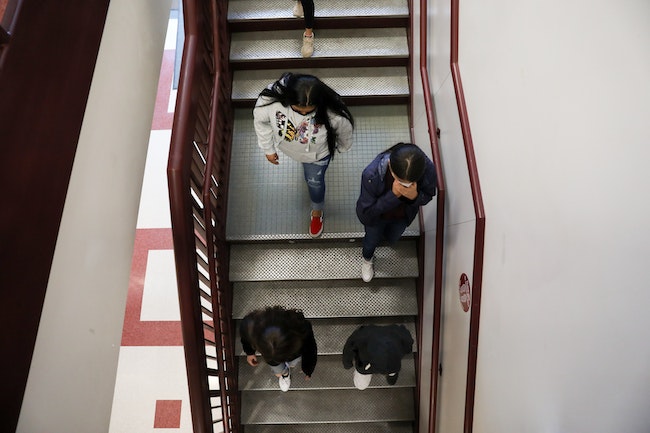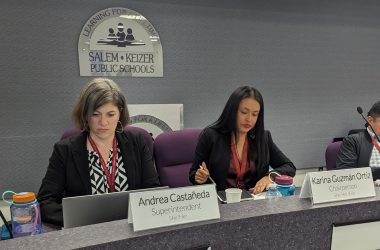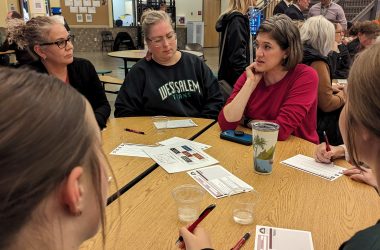
Students tour Houck Middle School on the first day of in-person sixth grade on Tuesday, April 13, 2021. (Amanda Loman/Salem Reporter)
Since Salem-Keizer schools resumed in-person classes for middle and high school students, a small sliver have contracted Covid and white students have been slightly more likely to return to the classroom.
Those are the takeaways from available data since secondary students came back to school buildings the week of April 12.
After about a year of online school, local schools resumed in-person classes gradually beginning March 2 with kindergarten and first-grade students. Older elementary school students were gradually phased in the following weeks, with middle and high school students returning about one month later.
Students remain in a hybrid schedule, attending in-person classes only two days per week. District administrators said they’re planning to resume full-time, in-person school for all families who want it in the fall.
Salem Reporter requested district data on student demographics for in-person and online school, as well as the number of students who have tested positive for Covid or had to quarantine following an exposure at school. Here’s what we found.
1. The vast majority of students opted to return to in-person classes
Of the roughly 22,000 middle and high school students enrolled in Salem-Keizer schools, about 18,700, or 85%, are signed up for hybrid classes, attending school two days per week in-person.
Nearly all of the students remaining online had previously enrolled in Enhanced Digital and Guided Education (commonly referred to as EDGE), Salem-Keizer’s exclusively online program, earlier in the school year.
That program was created over the summer amid uncertainty about if and when schools would be open for in-person classes. It was intended to serve students whose families knew they wanted to remain online all school year no matter how the pandemic unfolded.
Just 503 middle and high school students transferred to EDGE so they could remain online ahead of the in-person return, which began April 9.
The relatively low number in part reflects district policy that requires families to reach out to a school administrator to discuss transferring to all-online classes. Students who did so would also have different teachers and different courses available to them.
2. Most high schools have seen at least one Covid case, but none have reported widespread outbreaks
The district has recorded 26 cases of Covid among middle and high school students between April 13, when the first middle and high school students resumed regular classes, and April 28, district spokesman Aaron Harada said. That’s about 0.14% of all students attending in-person classes.
The Oregon Health Authority’s weekly Covid report from April 28 lists recent cases of students with Covid at North Salem, South Salem, West Salem, McKay and McNary high schools and Judson Middle School, as well as several district elementary schools. But none have recorded more than five cases among students.
Schools record any time a student who was in a school tests positive for Covid. That information is reported to local and state health authorities, whether or not the student caught Covid inside the school. Anyone in “close contact” with someone known to have Covid, defined as spending more than 15 minutes six feet from them, is then sent home to quarantine.
Harada said about 120 secondary students have had to quarantine since middle and high school classes resumed in-person. Most quarantines were the result of riding the bus with a student who had Covid, he said.
3. White students were slightly more likely to attend classes in-person, while Latino, Black and Asian students were more likely to attend online
Many large American school districts have seen significant differences in the willingness to resume in-person school along racial and ethnic lines. Black, Latino and Asian students have been more likely than their white peers to stay at home for a mix of reasons, including the disproportionately high rates of Covid.
Salem-Keizer has a similar pattern, but far less pronounced, with a clear majority of students of all races attending school in-person.
White students make up about 44% of the middle and high school student body, but 39% of students in those grades have remained online. Latino students, meanwhile, make up 44% of the student body, but 47% of those are attending online.
(Graphic by Rachel Alexander/Salem Reporter)
4. High school seniors were the least likely to transfer to all-online classes
The number of students in each grade who transferred to the all-online EDGE program rather than resume in-person classes was roughly even from sixth to eleventh grade. About 70 to 90 students in each grade opted to stay online.
Just 25 high school seniors joined them, suggesting local teens had a strong preference for seeing classmates and teachers in person before graduating.
Contact reporter Rachel Alexander: [email protected] or 503-575-1241.
BE PART OF OUR TEAM FOR SALEM’S BENEFIT: Accurate local information is vital for any community and that’s harder to come by in this day of “anyone can post anything” to social media. People in communities without trained journalists working for them don’t have accurate, trusted information. Help Salem avoid that fate – join in putting fuel in the tank of Salem Reporter to keep it growing, going strong. Here’s how:
SUBSCRIBE: A monthly digital subscription starts at $5 a month.
GIFT: Give someone you know a subscription.
ONE-TIME PAYMENT: Contribute any amount and you support giving the people of Salem local news otherwise missing. (You can also mail your contribution: Salem Reporter, 72585 Middle Fork Lane, Bates OR 97817)

Rachel Alexander is Salem Reporter’s managing editor. She joined Salem Reporter when it was founded in 2018 and covers city news, education, nonprofits and a little bit of everything else. She’s been a journalist in Oregon and Washington for a decade. Outside of work, she’s a skater and board member with Salem’s Cherry City Roller Derby and can often be found with her nose buried in a book.









